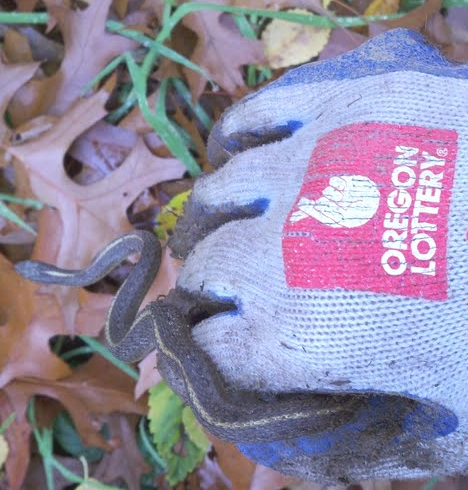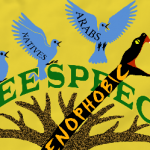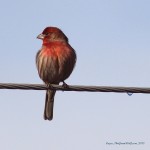I’ve been doing more tree planting while volunteering with SOLV. The last two Saturdays saw me down by Rock Creek southeast of Portland in the rain and mud, planting everything from snowberry bushes to willow trees in open areas along the creek. Our end goal was improving the health of the watershed and reducing erosion.
One weekend I was joined by a bunch of teenagers from a local high school. Not surprisingly, they were there because it was required to get extra credit in a biology class, and it didn’t seem like most of them wanted to be there. There was a lot of horseplay, the usual talk about who liked who and who was going out together, and once I had to tell a small group of boys to quit throwing clods of dirt into the creek (weren’t we trying to keep silt out of the water?)
Admittedly, I did get annoyed. I had been looking forward to this time outside as an opportunity to connect with the land there in a very hands-on way, and it was distracting wondering whether one of those lumps of dirt was going to fly by a little too closely. And why would you make kids come out to where they didn’t want to be and irritate the rest of us?
But then I stopped myself. Just because they were distracted didn’t mean they weren’t affected by what they were going. Maybe the louder ones just weren’t showing it, or maybe some of the quieter ones were getting more out of the experience. Either way, it wasn’t for me to judge whether they belonged there or not. They were getting trees and shrubs into the ground, adding their efforts to the work at hand. And wasn’t that enough, surely? If some of them remember this experience and it affects them in a positive way, now or later, that’s an additional bonus.
 We were all amazed when a small garter snake was unearthed by one of the volunteers. I went to take it into the grass, though not before everyone got a good look–the younger kids there were especially fascinated. I hope the snake was okay; mid November is a tough time to be roused from your safe place, though it was in the mid-50s, so not that cold. S/he had a small wound on her tail, just a nick, but I tried to clean the dirt from it anyway. Hopefully s/he found another place to send the winter, and the serpentine immune system will fight off any infection so s/he’ll be out again in the spring.
We were all amazed when a small garter snake was unearthed by one of the volunteers. I went to take it into the grass, though not before everyone got a good look–the younger kids there were especially fascinated. I hope the snake was okay; mid November is a tough time to be roused from your safe place, though it was in the mid-50s, so not that cold. S/he had a small wound on her tail, just a nick, but I tried to clean the dirt from it anyway. Hopefully s/he found another place to send the winter, and the serpentine immune system will fight off any infection so s/he’ll be out again in the spring.
I love it, though, when something so small and such a normal part of a healthy ecosystem awakens wonder in other people, even if only for a moment. I feel bad for the injured, displaced snake (though snakes are injured and displaced even without human interference), but I at least hope that in the process a few humans made a good memory that would last. If digging the trees in didn’t do it, perhaps a small serpent would.
Speaking of those memories, I found a little something extra that will certainly be a physical reminder of that day. When I plant trees, I like to start as close to the water as I can. The SOLV workers had placed a number of them right along the streambed, and that’s where I gravitated. I like being by running water; it helps me to ground myself into the ecosystem and the watershed I’m helping. But it’s also a good place to dig up interesting things buried in the ground over the years.
 Case in point, in between clay-thick dirt and big chunks of water-smoothed stone I found a small, hard, white object. Upon digging it up, I discovered a very old, circa 1920s Sanitol Hand Cream jar, milk glass and metal. Later on, when I cleaned it up at home, I found that other than a little damage to the lid it was in pretty good condition. Considering that it had been a few inches down, it had probably been in the ground for around ninety years. While there are much more toxic human-made things in the ground, something so not biodegradable is better off on a shelf in my home than in the soil along that creek.
Case in point, in between clay-thick dirt and big chunks of water-smoothed stone I found a small, hard, white object. Upon digging it up, I discovered a very old, circa 1920s Sanitol Hand Cream jar, milk glass and metal. Later on, when I cleaned it up at home, I found that other than a little damage to the lid it was in pretty good condition. Considering that it had been a few inches down, it had probably been in the ground for around ninety years. While there are much more toxic human-made things in the ground, something so not biodegradable is better off on a shelf in my home than in the soil along that creek.
We don’t always need to have physical objects to capture those realizations and experiences, though they can help. Often the memory alone carries itself. No one else left that day with an old jar, but perhaps they’ll always remember the dirt they dug (and occasionally threw), or a the trees they planted, or a little green garter snake drowsy in the autumn rain. And maybe those memories will stay with them, and encourage them to create more of these positive connections, whether in planting trees, or creating rituals, or writing for themselves and others. Who can say what memories were born that day?
















